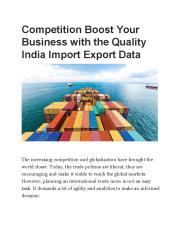Data on Quality of Government - PowerPoint PPT Presentation
1 / 13
Title:
Data on Quality of Government
Description:
To gather as much freely available data on QoG and is correlates and compile it ... Political indicators, instituions & election results. QoG what is it variables' ... – PowerPoint PPT presentation
Number of Views:40
Avg rating:3.0/5.0
Title: Data on Quality of Government
1
Data on Quality of Government
- Whats available?
- Where do you get it?
- Pros/ cons?
2
Our Website
- http//www.qog.pol.gu.se/
- Data codebook http//www.qog.pol.gu.se/data/QoG_c
odebook_v15May08.pdf - Dataset is updated about every 6 months
3
Purpose
- To gather as much freely available data on QoG
and is correlates and compile it into a single,
easily accessible and user-friendly data files. - To encourage world-wide interested in the
determinants of QoG, the effects of QoG, or both - To encourage cross-national ( time series) tests
and generalizable findings within good
governance research. - To address issues of reliability and validity in
data we provide ALL available indicators for
multiple tests.
4
Data sets
- Three versions
- Cross-sectional data 190 countries for 2002
(or closest year available) - Cross-sec., time series 200 countries from
1946-2006 (and counting) - QoG and Social Policy dataset cross-section
(192 countries) and time series (long-1946-2007
wide -1970-2005 40 countries) - Coming sub-national data in federal systems
5
Variables Included
- Versions 1 2
- A) What is it? variables corruption, rule of
law, bureaucratic quality, democracy indicators - -ex. World Bank indicators, Transparency
International, ICRG/ PRS Group, Freedom House,
Polity IV, etc. - B) How to get it? variables political
institutions (constitutional differences), legal/
colonial origin, press freedom,
ethno-linguistic-religious fractionalization - C) What you get variables environmental
indicators, gender equality, economic/ human
development indicators, social capital such as
trust in government
6
Cont.
- Version 3 (social policy)
- Heavier focus on relationship between QoG and
social/ public policy and redistribution
patterns. - 6 types of variables
- Social policy welfare, social security, etc.
- Tax policy
- Structural conditions income inequality,
education levels, health conditions, trade,
unemployment - Public opinion Eurobarometer, WVS, Eurpean
Social Survey rates satisfaction with S.P.,
trust ideology - Political indicators, instituions election
results - QoG what is it variables
7
1) Transparency International Corruption
Perceptions Index (CPI)
- Provides annual ranking of countries in terms of
perceived corruption in 180 countries (0-10).
Data is averaged between current year and
previous year - 2008 (20082007)/2 - Focuses on public sector corruption and defines
it as abuse of public office for private gain
ex. bribes, embezzlement, etc. - A composite index - 13 different survey
conducted by 11 independent IOs. Both business
people and country analyists/ experts resident
and non-residents are polled. Their pholosophy
more sources more reliability
8
- For ex. T.I. takes surveys from ADB, AFDB, BTI,
CPIA EIU, MIG and GI (Western risk assesment
firms) and combines them with IMD, FH, PERC and
WEF (residents), creating a standardized score
st. dev. Includes all countries that have at
least 3 scores available - The resident non-resident scores corrolate
- Time series comparisons should be made using a
countys SCORE not its rank - Is not able to detect global trends in corruption
- Wide coverage in data not until 1998
9
2008 Examples
10
World Bank Gov. Indicators (KKZ)
- Covers 6 areas of QoG
- Voice Accountability
- Political instability violence
- Government effectiveness
- Regulatory burden
- Rule of law
- Corruption (graft)
- Another composite index - surveys from 35
sources and 32 IOs to create an estimate and
c.i. for each country, bi-annually 212
countries - Households, buisness elites, NGOs and pub.
Sector - Range from -2.5 to 2.5
11
- Standardize each indicator, then aggregate annual
scores for each country (2002-2007, bi-annually
1996-2001), weighting more those sources that
correlate higher (Table 3 in article). - Has become one of the most widely used by
scholars and governments (US millennium
challenge aid prgram 2005). - Warn that if c.i.s overlap between two
countries, there is no statisically diff. between
them across space - 7 of countries have only 1 source on at least 1
indicator (down from 15 in 1996) - Like T.I., cannot reveal any global trends over
time - Example of sources and survey questions
- http//papers.ssrn.com/sol3/papers.cfm?abstract_id
1148386
12
2008 Rankings
- http//info.worldbank.org/governance/wgi/worldmap.
asp
13
Additional (free) indicators of QoGin our dataset
- ICRG (PRS Group) 1984-present corruption, r.o.l,
buro. Figures derived from country experts aimed
toward internatioanl investment firms rather than
a wide source of survey respondents (like T.I. or
W.B.) - Freedom House 1973-present political rights,
civil liberties, press freedoms - Frasier Institute, Heratige Foundation (economic
and finaicial freedom indices)































